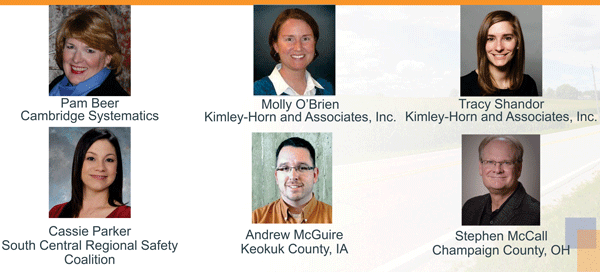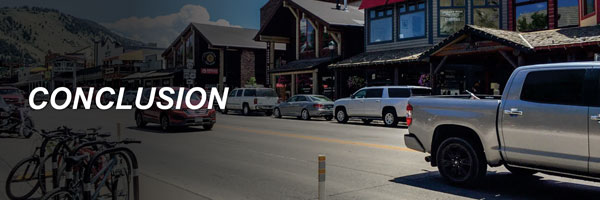Implementing A Local Road Safety Plan
[Printable version, PDF 4.5 MB]
slide 1
Implementing A Local Road Safety Plan
June 29, 2020
presented by
Federal Highway Administration, Office of Safety

slide 2
Presenters

slide 3
Housekeeping
- Instructions
- Hour presentation with half hour for Q&A
- All phones are muted
- Questions
- Q&A session will follow presentation
- If you have a question, write your question in Q&A (hover your mouse above or below your screen. Click on Q&A.)
- If you are having audio or video problems, let us know through the chat box
- A recording of the presentation will be made available
- A link to download the presentation will be provided in the chat box
- Webinar evaluation survey will come up in your web browser after the meeting
slide 4
Overview
- Poll Results
- Introduction
- LRSP Development
- Steps for Successful Implementation
- Conclusion

Photo courtesy of Getty Images
slide 5

Photo courtesy of Getty Images
slide 6
What is an LRSP?
- FHWA proven safety countermeasure
- Tool to improve safety on local roads
- Local roads have a fatality crash rate that is 75 percent higher than interstate

Photo courtesy of Molly O’Brien, Kimley-Horn and Associates, Inc.
Slide in greater detail:
An LRSP is a FHWA proven safety countermeasure that provides a framework for identifying, analyzing, and prioritizing roadway safety improvements on local roads.
slide 7
Implementing an LRSP
- LRSPs
- Provide a framework to identify analyze, and prioritize roadway safety improvements on local roads
- Many have adopted this approach
- Purpose of guide
- Focus on noteworthy practices
- Strategies for overcoming barriers and obstacles to implementation

Photo courtesy of Molly O’Brien, Kimley-Horn and Associates, Inc.
Slide content in greater detail:
While several States and local agencies have adopted this approach as a tool to improve safety on their local roads, many are finding it difficult to go from development to implementation.
This Implementing A Local Road Safety Plan report provides strategies local agencies and states have used to overcome barriers and challenges to successfully implement their plans along with noteworthy practices currently being used across the nation.
slide 8
Successful Implementation
- Approval of an implementation plan
- Execute safety projects/programs
- Deploy proven countermeasures
- Integrate 4E solutions
- Change agency policies and practices
- Reduce fatalities and serious injuries

Photo courtesy of Neil Hetherington WTI-MSU
Slide content in greater detail:
Successful implementation includes the following elements:
- Approval of an implementation plan from the county board or city council.
- Execution of identified safety projects/programs.
- Deployment of proven countermeasures.
- Integration of solutions across the 4Es of safety (engineering, education, enforcement, emergency response).
- Positive changes in an agency’s policies and practices that increase support for safety.
- A reduction in fatalities and serious injuries.
Successful implementation, however, can vary by jurisdiction.
slide 9
Successful Example

Slide content in greater detail:
Implementing an LRSP works. Washington State saw a 20 percent reduction in crashes on horizontal curves, and 30 percent reduction in overturn crashes after a number of counties in the state implemented their LRSP.
slide 10

Photo courtesy of Getty Images
slide 11
Impacts to Implementation
- Development activities that make implementation easier
- Obtain support and buy-in
- Find a champion
- Conduct data collection and analysis
- Identify funding mechanisms and allocate appropriate resources
- Determine the level of project detail
- Develop a clear vision
Slide content in greater detail:
How an LRSP is developed plays a large part in the ability of a locality or region to successfully implement their plan. Some development activities that can make the transition to implementation easier are:
- Obtain support and buy-in from officials and stakeholders that represent the 4Es of safety by providing information on the purpose of the LRSP, the benefits, and the role of officials and stakeholders.
- Find a champion who was involved in the development of the LRSP and can advocate for implementation of the LRSP. This individual can be a member of the jurisdiction’s board, another elected official, the jurisdiction’s engineer, or someone at the State DOT level.
- Conduct data collection and analysis that allows for implementation to be targeted at locations that will be the most effective at reducing fatalities and serious injuries.
- Identify funding mechanisms and allocate appropriate resources to help when it comes time to prioritize projects and strategies for implementation.
- Determine the level of project detail that is needed to obtain funding.
- Develop a clear vision and mission that will unite all stakeholders with a common goal.
slide 12
Existing Plans
- How to jump start implementation for existing LRSPs
- Reaffirm support from the champion(s)
- Strengthen support and buy-in from officials and 4E stakeholders
- Engage with others to implement behavioral safety countermeasures
- Clarify funding requirements and allocate appropriate resources
- Review the level of project detail so projects are ready to be submitted for funding
Slide content in greater detail:
If an LRSP already exists for your agency and you are ready to move into implementation or if there are struggles with moving into implementation, these actions may help jump start the process:
- Reaffirm support from the champion(s) identified during the development process and re-engage them and make sure they understand the LRSP is moving into implementation.
- Strengthen support and buy-in from officials and 4E stakeholders by providing information on what the locality will be doing in implementation.
- Engage with others to implement behavioral safety countermeasures such as law enforcement agencies, education and prevention specialists, and other highway safety community leaders. These individuals can be helpful in implementing the behavioral countermeasures.
- Clarify funding requirements and allocate appropriate resources which will help when it comes time to prioritizing recommendations and to obtain approval for the submitted list of projects.
- Review the level of project detail so projects in the LRSP are ready to be submitted for funding. This can be implementation as part of a larger construction project, as part of maintenance, or through dedicated funding streams. In other cases it may be filling out a project sheet that mirrors the funding application.
slide 13
LRSP Differences
- Funding for development
- Who develops
- Area covered
- Project selection
- Level of project development

Photo courtesy of Getty Images
Slide content in greater detail:
Several areas of differences in LRSP development include:
- Funding of LRSP Development – Some States fully fund LRSP development, fund a portion but require a local match, or the local agency can fully fund it. Research did not reveal a correlation between how development was funded and implementation.
- Who Develops the LRSP – LRSPs are developed by the local agencies in house, regional planning agencies or consultants procured at the State level, local level, or by the FHWA.
- Area Covered by the LRSP – LRSPs can be prepared for a county, city, MPO, Tribal area, or another region (State DOT district or region).
- Project Selection – Agencies use three major project selection methodologies in LRSP development: risk factor analysis, high-crash locations, or a combination of risk factor analysis and high-crash locations. For HSIP projects, they must be reflected in the State’s SHSP to be funded. If the LRSP contains behavioral safety projects or programs, funding for these must be obtained from the SHSO.
- Level of Project Detail – Once the projects have been identified, it is necessary to determine what level of detail or effort is needed to move a project from concept to actual implementation.
slide 14

Photo courtesy of Getty Images
slide 15

slide 16
Step 1 – Maintain Buy-In and Support
- Inform leaders and stakeholders
- Address citizen complaints/concerns
- Identify a champion
- Obtain support from colleagues

Slide content in greater detail:
There are four things to do to maintain buy in and support for LRSP implementation:
- Inform Leaders and Stakeholders – It is important to keep leaders and stakeholders informed about the implementation progress, achievements, and challenges on a regular basis.
- Address Citizen Complaints/Concerns – As implementation moves forward, there may be objections or concerns raised about a particular project. The official can provide information on the benefits of a particular project or approach in a written or oral communication such as a letter, email, or phone call or speak about the improvements at a community or other meeting.
- Identify a Champion – A champion is someone who takes a leadership role in planning, promoting, and implementing the LRSP. This person is usually the individual who speaks about the plan at meetings, promotes the plan to State officials, and becomes the public face of the LRSP to officials and stakeholders.
- Obtain Support from Colleagues – In addition to backing from officials at the agency or board/county level, successful implementation also requires buy-in and support from colleagues within the local agency including maintenance, design, and construction.
slide 17
Step 1 – Maintain Buy-In and Support
Recommendations
- Reach out to new agency and elected officials
- Stakeholder meetings
- Fact sheet
- Share success stories
- Incorporate others (maintenance, development, etc.)
Slide content in greater detail:
Following are recommendations that will help to maintain support and buy-in for implementation of the LRSP.
- Reach out to current and any new agency or elected officials that have changed since the plan was developed. Schedule and conduct a meeting with these individuals, if possible, or send them the LRSP document and other related information about the plan.
- Conduct on-going, regular meetings for stakeholders to keep them informed on implementation plans and progress.
- Develop a one- to two-page fact sheet on the LRSP that includes why the plan was developed (data on the traffic crash problem and the number of fatalities and serious injuries), and what type of projects are planned to address the problem.
- Request a briefing or presentation to the agency board and a meeting with the local agency officials to describe what is planned for implementation. In some cases, it may be necessary to explain why certain projects were selected.
- Collect information throughout implementation on results of implementation and make sure to share information with officials and stakeholders on a regular basis. This can be as simple as a quick email message or an e-newsletter.
- Determine where other offices within the local agency can be of assistance such as maintenance and bring them into the implementation process in the beginning so they can offer suggestions on where they can help. In fact, it may be a good idea to bring in maintenance staff during the development process since they may have ideas on what projects would fit in with their work plan.
Maintaining buy-in and support from officials and stakeholders during implementation is not a one-time activity. It is an ongoing process that needs to be maintained throughout so individuals understand what is being accomplished.
slide 18
Step 1 – Louisiana Houma-Thibodaux MPO – Cassie Parker
- South Central Regional Safety Coalition Regional LRSP
- Collaboration between Safety Coalition and MPO Technical Advisory Committee
- Joint quarterly meetings to review projects, address safety concerns, monitor crash data, evaluate priorities, determine available funding sources, and identify best practices and policies
- Provide periodic updates in presentations to area MPO Policy Committee, area MPO Board
- Provide information on current safety trends
- Crash data on local roads
- Road safety assessment findings
- Proven effective countermeasures to address specific crash types
- Funding sources
- Best Practices and policies for local governments to adopt

Slide content in greater detail:
Cassie Parker with the South Central Regional Safety Coalition that is part of the Houma-Thibodaux MPO will describe how she maintained support and buy-in from the MPO board for their regional safety plan.
slide 19
Step 2 – Identify Funding Mechanisms
- HSIP funding
- HSIP application process
- HSIP funding availability for local agencies
- Perception of difficulty using HSIP funds
- Behavioral safety funding
- Other funding sources

Photo courtesy of Neil Hetherington WTI-MSU
Slide content in greater detail:
There is a variety of available funding for LRSP implementation.
- HSIP Funding – HSIP funds are sought for implementation of most projects in the LRSPs. There are challenges associated with this funding including the State’s HSIP application process; HSIP funding availability for local agencies; and the perception that the administrative burden is difficult to manage.
- Behavioral Safety Funding – Since some LRSPs include recommendations for both engineering and behavioral safety countermeasures within their plan, there are grants available from the State Highway Safety Office to implement programs in key behavioral safety areas including impaired driving, speeding, occupant protection, motorcycle safety, pedestrian and bicycle safety, school buses, enforcement of traffic laws, traffic records, emergency services, commercial vehicle safety, and driver’s education. Behavioral safety funding is also available from private sector sources such as insurance companies and car manufacturers.
- Other Funding Sources – These sources include bicycle/pedestrian improvement funding; sign replacement programs; funding form an MPO, Tribal safety funding, bond programs, or a transportation alternatives program.
slide 20
Step 2 – Identify Funding Mechanisms
Recommendations
- Determine potential funding sources
- Identify HSIP funding opportunities
- Review opportunity for overlap with capital improvement projects
- Verify if public/private partnerships are available
Slide content in greater detail:
- Meet with your local agency manager or the Executive Directors of MPOs in your area to find out what funding is available locally for safety projects. For instance, there may be a Vision Zero program that has funding for pedestrian improvements. It is also a good idea to meet with that program manager to see where project and program implementation efforts match those in the LRSP.
- Meet with the relevant personnel at the DOT who administers the HSIP funding. It may be the safety engineer, but it also may be someone else. Ask the safety engineer who to contact and meet with them to discuss available funding. While HSIP will most likely be the major source of funding, there may be Federal and State funding that can be used. Familiarize yourself with these funding streams and learn what requirements are involved.
- Review the current list of capital improvement projects to determine where recommendations from the LRSP overlap with future planned projects and determine if it is possible to include the projects within the existing funding or whether budgets can be increased or modified to include the recommended safety improvements.
- Determine whether it is possible to fund portions of the LRSP through public/private partnerships. These partnerships have been utilized on the State and local level. Check with the head of your public works or transportation department, county or city manager, or State DOT safety engineer to determine whether this is something to pursue.
slide 21
Step 2 – Caltrans
- Local Roadway Safety: A Manual for California’s Local Road Owners
- Guidance on the HSIP application process and the types of safety improvements that could be funded
- SSARP (Systemic Safety Analysis Report Program)
- Address local agency reluctance to apply for HSIP funding
- Assisted local agencies with the information needed for HSIP application
- Name changed to LRSP
Slide content in greater detail:
Caltrans developed the “Local Roadway Safety: A Manual for California’s Local Road Owners,” which included guidance on the HSIP application process and the types of safety improvements that could be funded under HSIP and local match requirements. To further encourage local agencies to apply for HSIP funds, Caltrans then developed SSARP to address local agency reluctance to apply for HSIP funding because it was tied to Federal funding requirements and they did not have the resources to meet those requirements. The SSARP assisted local agencies with the information needed for their HSIP application. Many of the applications were to fund an LRSP development process.
slide 22
Step 3 – Identify and Prioritize Projects
- Network screening
- Systemic safety analysis process
- Data analysis
- Benefit-cost analysis
- Cross jurisdictional ownership
- Link with priorities in other plans
- Other approaches (other planned projects or policy/political reasons)

Photo courtesy of Brian Keierleber, Buchanan County, IA
Slide content in greater detail:
Identification of LRSP projects usually takes place during the LRSP development. However, there may be a need to further identify projects during implementation. There are a variety of ways that projects can be identified and prioritized:
- Network screening is used to identify sites for further investigation and potential treatment.
- Systemic safety analysis process involves improvements that are widely implemented based on high-risk roadway features correlated with particular severe crash types.
- Data analysis can identify project locations and appropriate countermeasures during the development of the LRSP, and also be used as a way to prioritize projects.
- Benefit-cost analysis compares all the benefits associated with a countermeasure expressed in monetary terms, to the cost of implementation.
- Cross jurisdictional ownership is where roadways at an intersection are owned by the local agency and the State.
- Link with priorities in other plans such as the emphasis areas in the state’s SHSP.
- Other approaches include piggy backing on already planned projects such as repaving or there may be policy or political reasons.
slide 23
Step 3 – Identify and Prioritize Projects
Recommendations
- Utilize appropriate methods to identify projects
- Identify projects that address most serious safety concerns
- Benefit-cost analysis
- Prioritize based on funding application requirements
Slide content in greater detail:
Following are recommendations that will help identify and prioritize projects in the LRSP:
- Utilize the appropriate methods to identify projects including network screening and systemic safety analysis. These methods can be used individually or in combination which will ensure an examination of the whole local road system.
- Refer to the data to identify what projects would address the most serious traffic safety problems.
- Use other methods to determine the advantages of implementing one project over another such as benefit-cost analysis and select those that have a higher benefit (crash reduction) in relation to the cost of implementation.
- Have a clear understanding of the funding requirements to prioritize their projects and position them for successful funding applications.
- Determine if project prioritization has already been accomplished in other safety plans including the SHSP.
slide 24
Step 3 – Washington State
- Provided each county with crash statistics
- Conducted training on systemic safety analysis process
- Held a workshop on project prioritization
- Cowlitz County, WA
- Developed list of prioritized projects with estimated cost
Slide content in greater detail:
Determining the right projects that would yield results at the local level was a key concern of the Washington State DOT. The DOT was highly supportive of the LRSP process but wanted to ensure counties in the State had enough knowledge and information to select and implement cost-effective projects. The DOT provided each county with crash statistics, conducted training on the systemic safety analysis process and a workshop on project prioritization. Cowlitz County, WA, one of the first counties in the State to develop an LRSP, developed a list of prioritized projects based on the crash data and information gained through the workshop and training. They also provided an estimated cost for each project. This list was submitted to the DOT, and the DOT made the final decision on what was implemented in the county.
slide 25
Step 4 – Deliver Projects
- Design
- Design build
- Project bundling
- On-going maintenance
- Other methods

Photo courtesy of Brian Keierleber, Buchanan County, IA
Slide content in greater detail:
After a project has secured all the necessary funding, the next step is project delivery which is where a project is taken from concept to completion. Elements in project delivery include:
- Design which is where the initial project is designed. Some local agencies have staff and resources to design improvements in-house or with consultants, while other agencies do not.
- Design build is when a locality or State will design and build a project concurrently, which consolidates the process.
- Project bundling can occur when multiple projects of the same type within one agency are bundled together or multiple agencies bundle projects together. It is a way for multiple local agencies or the State and a local agency to come together and implement similar projects on roadways across multiple jurisdictions.
- On-going maintenance can be utilized for project implementation. Maintenance crews generally possess detailed knowledge of every section of the local agency’s roads, including current problem areas and those likely to be problematic in the future. Projects can be implemented by integrating them with resurfacing, restoration, and preservation efforts.
- Other project delivery methods that have been successfully utilized for implementation include having the State DOT complete the projects that intersect with State roadways, the use of force accounts, or using State sign replacement programs.
slide 26
Step 4 – Deliver Projects
Recommendations
- State provide assistance to local agencies
- Project bundling
- On-going maintenance
Slide content in greater detail:
There are several creative ways that LRSP projects can be implemented through different project delivery methods including the following:
- State DOTs assist local agencies with design help (either in-house or from consultants) or by offering design build assistance to aid in a more streamlined way to implement projects.
- Project bundling is an innovative way to implement projects from the LRSPs. Some agencies bundle similar projects or projects near each other, while other agencies have bundled projects across multiple jurisdictions.
- On-going maintenance is utilized for completing projects and recommendations that can be completed as part of routine maintenance projects.
Agencies should also consider the project delivery methods identified to aid with implementation of their LRSPs.
slide 27
Step 4 – Keokuk County, IA
- Andrew McGuire, County Engineer
- Used project bundling to complete multiple projects
- Projects were similar in nature and near each other
- Mainly low-cost safety improvements

Photo courtesy of Andrew McGuire, Keokuk County, IA
slide 28
Step 5 – Evaluate Implementation
- Output and outcome evaluation
- Process evaluation

Photo courtesy of Molly O’Brien, Kimley-Horn and Associates, Inc.
Slide content in greater detail:
There are two primary types of evaluation – outcome and output evaluation and process evaluation.
Outcome evaluation is used to determine if there was an impact from the implementation of the engineering and behavioral improvements in the LRSP. Usually this is reductions in traffic related fatalities and serious injuries on local roads. Output evaluation determines whether the project was completed which answers one of the two basic questions of evaluation – did we do what we said we would do and was it effective. Output evaluation usually counts things like the number miles where rumble strips have been installed.
Process Evaluation can be used to identify potential opportunities and inform future decision making, which can lead to process changes. Local agencies respond to citizen complaints, but it is important to have data on hand to show that what the agency is implementing will have a lasting and beneficial impact on safety. A citizen might complain about a “dangerous” intersection, but an examination of the data could reveal the location was not an issue from a crash perspective.
slide 29
Step 5 – Evaluate Implementation
Recommendations
- Update the plan
- Identify metrics
- Expand stakeholders
Slide content in greater detail:
Conducting an evaluation on projects after they are implemented can be valuable to educate and obtain support from the community for implementation of future projects. Additionally, the evaluation results can help agencies determine what types of projects to focus on for future efforts.
- Update the Plan: As conditions in a county or region change, it will be necessary to change the LRSP. In Minnesota, several counties are already looking to revise their plans because they have implemented most projects. Establishing a regular update process may be worthwhile. The average number for most other safety plans is five years.
- Identify Metrics: There should be some way to measure the impact of the LRSP. Reductions in fatalities and serious injuries are the major metric that indicates whether the plan is successful, but there may be other ways to determine success. Identifying output measures, for instance, that indicate the level of activity such as the miles of rumbled strips installed or the number of curves that have been modified are ways to show progress.
- Expand Stakeholders: It will always be necessary to update the stakeholders who are involved in the LRSP. In addition to replacing stakeholders who have retired or moved to other jobs, look to include people who have not been involved previously. For instance, it may be a good idea to involve law or representatives from the SHSO as implementation moves forward.
slide 30
Step 5 – Minnesota
- 85-90 percent of counties have implemented an LRSP
- DOT receives over 100 applications for funding each year
- St. Louis County, MN
- Between 2012 and 2017, 35 percent reduction in fatality rate on county road system
Slide content in greater detail:
In Minnesota, the DOT has defined success as the 85-90 percent of the counties that have implemented a project from the LRSP. The DOT receives over 100 applications for funding each year. St. Louis County, MN also reported that between 2012 and 2017 there was a 35% reduction in the fatality rate on the statewide county road system.
slide 31
Step 6 – Communication & Coordination
- Coordination with State DOT and LTAP
- Outreach to other stakeholders

Photo courtesy of FHWA
Slide content in greater detail:
Implementation requires greater emphasis on marketing and communication to keep interest in the LRSP active and alive. Some activities that are needed include:
Coordination with State DOT and LTAP – Often localities that have developed and are now implementing LRSPs have close working relationships with the DOT and the LTAP.
Outreach to Other Stakeholders – Several localities are looking to other stakeholders such as law enforcement and behavioral highway safety specialists to broaden implementation of the LRSP by bringing in different perspectives on highway safety problems. Examples of this different perspective can be information on what law enforcement sees as they travel the roadways or what they have found when investigating a crash. Behavioral safety specialists may have ideas on how the LRSP can help change the safety culture in the locality or region by also focusing on road user behavior issues.
slide 32
Step 6 – Communication & Coordination
Recommendations
- Incorporate stakeholders with representation from 4Es
- Promote safety message through marketing success stories
- Social media
- Conferences
- Newsletter
- Presentations
Slide content in greater detail:
To keep communication going and the LRSP at the forefront and ensure greater coordination consider the following:
- Ensure everyone is on board, and all stakeholders are accounted for including representation from the 4Es of safety – engineering, enforcement, education, and emergency medical services
- Message across communication channels and programs so all available communication channels are used to promote the safety message (e.g., news, social media, television, industry associations, and videos).
- Meet with elected officials and attend committee and board meetings and workshops; prepare hot topic memos on emerging safety issues (e.g., pedestrian fatalities, and intersection crashes).
- Host conferences/webinars to keep a focus/awareness on local road safety:
- Minnesota TZD meetings includes representatives from the 4Es.
- The Arizona Safety Summit includes a focus on rural transportation.
- Develop a newsletter or e-newsletter or memorandum that can be sent to all stakeholders updating them on implementation progress. This can include a description of projects that have started along with photos whenever possible, information on changes in traffic fatalities and serious injuries in the jurisdiction, or even extraordinary safety efforts by 4E partners such as a local police officer who had an outstanding arrest record for impaired drivers. The county public information officer may be willing to help set up the newsletter and even aid in compilation and distribution.
- Request and conduct regular presentations on the LRSP to the county, city, or regional board or council. These presentations can describe projects being implemented, provide any results when available, or information on new crash or safety trends. For instance, agencies may want to report on any increases in fatalities or serious injuries such as a spike in pedestrian fatalities and injuries.
- Post photographs, graphs or charts on the jurisdiction’s web site or Facebook page. These can be photographs of the safety projects being started or updated fatality and serious injury charts.
- When you learn that a project may generate public opposition or criticism, it may be a good idea to schedule a meeting with the chair of your board or council and send follow up written documentation to let them know what you are doing, why it is important to improve safety, and why it may generate criticism.
slide 33
Step 6 – Champaign County, OH
- Stephen McCall, County Engineer
- Champaign County, OH used a unique way to reach out to stakeholders called the C-H-A-R-M process:
- C – Communicate with phone, emails, announcements; follow-up with thank you and outcomes
- H – Help – ask for it
- A – Activist – actively participate and volunteer for other groups
- R – Relationships – know who you are talking to and make a connection with them
- M – Motivate –make it personal. Worked with Safe Communities Coalition
slide 34

Photo courtesy of Getty Images
slide 35
Steps to Consider
- Engage your stakeholders
- Find a champion
- Identify funding mechanisms
- Prioritize projects
- Allocate appropriate resources
- Determine project development
- Undertake project delivery
- Conduct evaluation
- Continue communication and coordination

Slide content in greater detail:
While development of LRSPs is widespread, implementation of LRSPs has been challenging for some agencies. Some steps to consider for implementation:
- Engage your 4E stakeholders: Bring stakeholders from the development process back together and give them roles and responsibilities.
- Find champion: A local, regional, or statewide champion who was involved in the development of the LRSP and supports implementation of the LRSP will make it easier to transition to implementation.
- Identify funding mechanisms: In implementation, knowing what funding is available will help with both the project prioritization and project delivery.
- Prioritize projects: Overall project prioritization makes implementation easier and allows localities to prepare for the next funding cycle.
- Allocate appropriate resources: Determine what manpower and management are needed to take the projects through the project delivery process
- Determine project development: Determine if there are tools that can help with implementation or whether a consultant is needed
- Undertake project delivery: This can be help in the design process on through to actual installation.
- Conduct evaluation: Conducting an evaluation can be valuable to educate and obtain support from the community for implementation.
- Continue communications and coordination: Continually educate key elected and agency officials, colleagues, other stakeholders and the public about the value of the LRSP, the identified projects and how it is achieving positive results.
slide 36
The Report
FHWA-SA-20-025

slide 37
For More Information
Rosemarie Anderson
Federal Highway Administration
Office of Safety
Rosemarie.Anderson@dot.gov
Karen Scurry
Federal Highway Administration
Office of Safety
Karen.scurry@dot.gov
slide 38

Photo courtesy of Getty Images
























